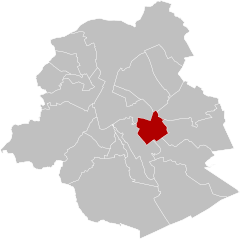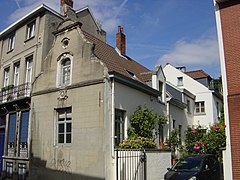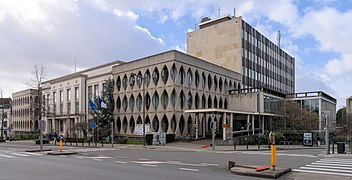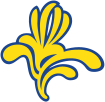Etterbeek
 From Wikipedia - Reading time: 12 min
From Wikipedia - Reading time: 12 min
Etterbeek | |
|---|---|
 Etterbeek's Municipal Hall | |
| Coordinates: 50°50′N 04°23′E / 50.833°N 4.383°E | |
| Country | |
| Community | Flemish Community French Community |
| Region | Brussels-Capital |
| Arrondissement | Brussels-Capital |
| Government | |
| • Mayor | Vincent De Wolf (MR) |
| • Governing party/ies | LB-Ecolo-PS |
| Area | |
• Total | 3.17 km2 (1.22 sq mi) |
| Population (2020-01-01)[1] | |
• Total | 48,473 |
| • Density | 15,000/km2 (40,000/sq mi) |
| Postal codes | 1040 |
| NIS code | 21005 |
| Area codes | 02 |
| Website | www.etterbeek.be/fr (in French) www.etterbeek.be/nl (in Dutch) |
Etterbeek (French: [etœʁbek, -bɛk] ; Dutch: [ˈɛtərˌbeːk] ) is one of the 19 municipalities of the Brussels-Capital Region, Belgium. Located in the eastern part of the region, it is bordered by the municipalities of Auderghem, the City of Brussels, Ixelles, Schaerbeek, Woluwe-Saint-Lambert and Woluwe-Saint-Pierre. In common with all of Brussels' municipalities, it is legally bilingual (French–Dutch).
History
[edit]Origins and etymology
[edit]According to legend, Saint Gertrude of Nivelles, daughter of Pippin of Landen, founded a chapel there in the 8th century. A document by Holy Roman Emperor Otto I, dated 966, mentions the church of Iatrebache. The name Ietrebecca—possibly from the Celtic root ett meaning "rapid movement" and the Dutch word beek meaning "stream"—is found for the first time in a document dated 1127. The current spelling appears eleven years later in 1138, around which time a newer and larger church was built.
Middle Ages
[edit]
In the Middle Ages, Etterbeek was a rural hamlet mostly independent of Brussels, aside from taxation rights on beer given to Brussels around 1300 by Duke John II of Brabant. The following two centuries counted several grievous moments: in 1489, Duke Albert III of Saxony ravaged Etterbeek in his pursuit of the rebels who fought against Holy Roman Emperor Maximilian; in 1580, the village was destroyed again, this time by iconoclasts during the Protestant Reformation wars. Peace returned under the reigns of the Archdukes Albert VII and Isabella.
Barony and municipality
[edit]In 1673, Etterbeek gained its independence from neighbouring Sint-Genesius-Rode, when King Charles II of Spain promoted it into a barony. The first baron was Don Diego-Henriquez de Castro, general treasurer of the Netherlands armies. The Castro house was sold in 1767 and can still be seen today as Etterbeek's oldest building.
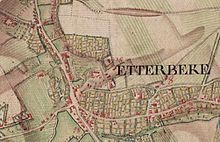
Under the French regime, Etterbeek was made into a commune, within the canton of Sint-Stevens-Woluwe. From then on, and especially after the Belgian Revolution of 1830 and the development of Brussels as a capital city, the population of Etterbeek grew quickly. In 1876, there were more than 10,000 inhabitants, in 1900 more than 20,000, and in 1910 more than 33,000. In the 1900s (decade), under the reign of King Leopold II, construction boomed and changed the town's character with the addition of the broad avenues and residential areas that exist today.
Places of interest
[edit]- Two Roman Catholic churches are located in Etterbeek: the Church of Saint Anthony of Padua and the Church of Our Lady of the Sacred Heart. A third church—the Church of Saint Gertrude—was demolished in 1993, as it was in danger of collapsing.
- The Cauchie House was built in 1905 by the Art Nouveau architect, painter, and designer Paul Cauchie. Its facade is remarkable for its allegorical sgraffiti.
- Of a completely different character, the Barony House dates from 1680 and is the oldest building in the municipality.
- The Fondation René Carcan, a foundation and museum in the engraver and sculptor René Carcan's old studio, was located in Etterbeek.
- The Chaussée de Wavre/Waversesteenweg has, since 27 September 2014, featured a series of large scale Le Chat drawings by the cartoonist Philippe Geluck, who was born and raised in this neighbourhood. The 24 drawings extend over a total length of 120 metres (390 ft).[2]
- Etterbeek has a few green areas, including Jean-Félix Hap Garden. The better known Parc du Cinquantenaire/Jubelpark lies on the territory of both the City of Brussels and Etterbeek, and Leopold Park borders the municipality's territory.
The main university campus of Vrije Universiteit Brussel (VUB) is called Campus Etterbeek, although it is geographically not within Etterbeek but in the adjacent Ixelles.
-
Barony House (1680)
-
A typical Etterbeek street: the Rue des Boers/Boerenstraat
-
Cauchie House by Paul Cauchie (1905)
-
Sgraffito panel in the Cauchie house
-
Place Jourdan/Jourdanplein
-
Jean-Félix Hap Garden
-
Former Municipal Hall
Demographics
[edit]Etterbeek has a large immigrant population, with both the EU and non-European migrant communities outnumbering the native Belgians. Akin to neighbouring Ixelles and Schaerbeek, Etterbeek also has a large Muslim population, mainly of North African origin.[3]
| Group of origin | Year | |
|---|---|---|
| 2023[4] | ||
| Number | % | |
| Belgians with Belgian background | 11,169 | 22.54% |
| Belgians with foreign background | 13,191 | 26.62% |
| Neighbouring country | 1,695 | 3.42% |
| EU27 (excluding neighbouring country) | 2,207 | 4.45% |
| Outside EU 27 | 9,289 | 18.74% |
| Non-Belgians | 25,198 | 50.85% |
| Neighbouring country | 6,233 | 12.58% |
| EU27 (excluding neighboring country) | 11,734 | 23.68% |
| Outside EU 27 | 7,231 | 14.59% |
| Total | 49,558 | 100% |
Transport
[edit]Etterbeek is served by Etterbeek railway station but, like the neighbouring campus of the Vrije Universiteit Brussel (VUB), it is also located in Ixelles. Etterbeek currently has one railway station (Mérode) and three metro stations (Mérode, Thieffry and Pétillon).
Sports
[edit]- Etterbeek hosts two football clubs (R.R.C. Etterbeek and Armenia) playing in Belgian Provincial leagues at the Guy Thys Stadium, thus named after the famous Belgian manager since 2003. He led the Belgium national football team to fourth place at the 1986 FIFA World Cup.
- In the summer of 1996, the municipal swimming pool burnt down. It has now been rebuilt and is again open to the public.
Proposed redevelopment "Les Jardins de la Chasse"
[edit]This article needs to be updated. (December 2022) |
A project is currently proposed to redevelop an area of Etterbeek near the Avenue des Casernes/Kazernelaan. This project would result in the Municipal Hall and police station being relocated to new buildings in a central administrative centre on this site.[5] The new site is being called the Jardins de la Chasse in French or Tuinen van de Jacht in Dutch. Demolition of the former CPAS building on the site started in 2014,[6] and building of houses on the site started in 2016, with construction of the new Municipal Hall awaiting administrative approval.[7] Municipal offices are forecast to move to the new location in summer 2018. The site of the current Municipal Hall may in the future be used for further residential development.[6]
Events
[edit]
Etterbeek hosts an annual medieval market. Previously held at the end of May on Avenue du 2ème Régiment de Lanciers/2de Lansiers Regimentlaan to the south of the municipality, in recent years, it has taken place at the Cinquantenaire.
Notable residents
[edit]Born in Etterbeek:
- Jérôme d'Ambrosio (born 1985), racing driver
- Jean Brachet (1909–1998), biochemist
- Misha Defonseca (Monique De Wael) (born 1937), writer of Misha: A Mémoire of the Holocaust Years
- Pierre Deligne (born 1944), Fields Medal-winning mathematician
- François Englert (born 1932), Nobel Prize-winning physicist
- Giani Esposito (1930–1974), actor
- Lara Fabian (born 1970), singer-songwriter
- Annie Fargé (1934–2011), actress
- Marouane Fellaini (born 1987), footballer
- Philippe Francq (born 1961), cartoonist
- André Franquin (1924–1997), cartoonist, creator of Gaston and Marsupilami
- Philippe Geluck (born 1954), cartoonist, creator of Le Chat[8]
- Georges Grün (born 1962), football defender
- Arthur Maurice Hocart (1883–1939), anthropologist
- Daniel Hulet (1942–2011), cartoonist
- René Kalisky (1936–1981), playwright, novelist, essayist, journalist, and historian
- Michel Ledent, also known as Midam (born 1963), cartoonist
- Roland Lethem (born 1942), filmmaker and writer
- Charles Lambert Manneback (1894–1975), physicist, mining engineer, and mathematician
- Alexandre de Merode (1934–2002), member of the International Olympic Committee (IOC)
- Constantin Meunier (1831–1905), painter and sculptor
- Eliane Morissens (1927–2006), LGBT activist known for protests on employment discrimination[9]
- Fabrice Mvemba (born 1980), footballer
- Amélie Nothomb (born 1966), writer
- Charles Picqué (born 1948), politician, freemason, and mayor of Saint-Gilles
- Godelieve Quisthoudt-Rowohl (born 1947), German politician
- Georges Remi, also known as Hergé (1907–1983), cartoonist, creator of The Adventures of Tintin
- Andre Sapir (born 1950), economist
- Stromae (Paul Van Haver) (born 1985), singer-songwriter, rapper, and producer
- Herman Van Rompuy (born 1947), politician, Prime Minister, and first permanent President of the European Council
Lived part of their life in Etterbeek:
- Jean Absil (1893–1974), composer and organist
- Jean-Baptiste Baronian (born 1942), Belgian-Armenian writer
- René Carcan (1925–1993), engraver and sculptor
- Adrien de Gerlache (1866–1934), officer of the Belgian Navy and leader of the Belgian Antarctic Expedition
- Luigi Di Maio (born 1986), Italian Minister of Foreign Affairs, EU Special Envoy to Arab Gulf States
- W.F. Hermans (1921–1995), Dutch writer
- Edgar Pierre Jacobs (1904–1987), cartoonist, creator of Blake and Mortimer
- Gaston Salmon (1878–1917), épée fencer, Olympic champion
Buried in Etterbeek:
- Moise Tshombe (1919–1969), Congolese politician
International relations
[edit]Twin towns and sister cities
[edit]Etterbeek is twinned with:
 Fontenay-sous-Bois, France
Fontenay-sous-Bois, France Forte dei Marmi, Italy
Forte dei Marmi, Italy Beauport, Quebec, Canada
Beauport, Quebec, Canada Essaouira, Morocco
Essaouira, Morocco
References
[edit]- ^ "Bevolking per gemeente op 1 januari 2020". Statbel.
- ^ "24 nuances de Chat à la Chasse" (PDF). La Vie Etterbeekoise (in French). No. 2. October 2014. p. 3. Archived from the original (PDF) on 15 July 2015. Retrieved 3 May 2015.
- ^ "Belgians' Fear of Radical Islam Takes a Front Seat". Haaretz. Retrieved 4 July 2023.
- ^ "Origin | Statbel". statbel.fgov.be. Retrieved 4 July 2023.
- ^ Les Jardins de la Chasse (Slide deck) (in French). Archived from the original on 23 September 2008. Retrieved 12 October 2008 – via etterbeek.irisnet.be.
- ^ a b Julien Thomas (22 September 2014). "Les Jardins de la Chasse verront le jour d'ici 2019" (in French). dh.be. Retrieved 23 January 2017.
- ^ Patrice Leprince (1 February 2016). "Etterbeek: les Jardins de la Chasse se profilent" (in French). Le Soir. Retrieved 23 January 2017.
- ^ "" Ma tête et mon cœur sont Etterbeekois ! "" (PDF). La Vie Etterbeekoise (in French). No. 2. October 2014. p. 3. Archived from the original (PDF) on 15 July 2015. Retrieved 3 May 2015.
- ^ Council of Europe Staff (1992). "Case-law of the Commission: 2. Application No. 11389/85 Eliane Morissens v. Belgium". Yearbook of the European Convention on Human Rights, 1988. Dordrecht, The Netherlands: Martinus Nijhoff Publishers. pp. 40–45. ISBN 978-0-7923-1787-6.
External links
[edit] Media related to Etterbeek at Wikimedia Commons
Media related to Etterbeek at Wikimedia Commons- Official website of Etterbeek, in French and Dutch
 KSF
KSF



